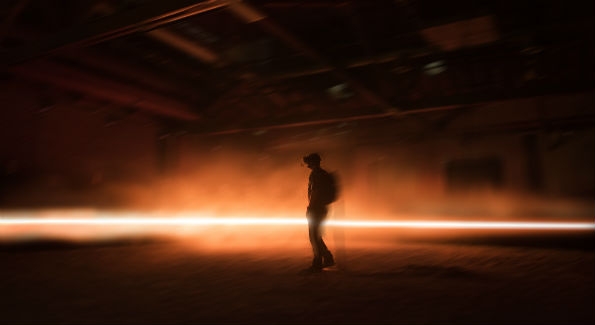The haunting virtual reality exhibit ‘Carne y Arena’ takes visitors on a border crossing journey that blurs the lines between art and politics.

A user in the experience. Photo credit: Emmanuel Lubezki
Mud- caked sneakers, frayed wedges, torn up boots and other miscellaneous footwear are strewn across a cold, sterile room where you are asked to take off your own shoes. Barefoot on the icy concrete floor, you read a sign explaining that each shoe has been collected from the U.S.- Mexican border, across which thousands of immigrants attempt the harrowing journey into America every year. With no phones or companions permitted, you find yourself unable to take your eyes off a single toddler-sized Croc flipped on its side – small in scale, but large in symbolism. It alludes to the controversial immigration debate that has captured headlines in recent months amid President Donald Trump’s threats to rescind the Deferred Action for Childhood Arrivals (DACA) program enacted by President Obama. Who does that shoe belong to, you wonder.
In that moment Academy-Award-winning director (“Birdman,” “The Revanant”) Alejandro G. Iñárritu has succeeded in his goal to create an experience that forces you to think about the individuals behind immigration statistics. These real life stories from Mexican and Central American refugees haunted Iñárritu and fueled his virtual reality project “Carne y Arena” (which loosely translates to “Flesh and Sand” in Spanish).
From the cold room, meant to mimic the “freezer” where immigrants are detained if caught by border patrol, you enter a large, dark expanse covered in pebbles and sand. There you are fitted with VR goggles and a backpack that keeps you from running into the surrounding walls.
In mere seconds you are transported to the middle of a desert, in the dead of night, in the throes of a border crossing.
The six-and-a-half minute encounter that ensues is equal parts chaotic, horrifying and heart-wrenching, offering a tiny fraction of the terror a migrant might face while attempting to reach a better life in the U.S. The exhibit closes with filmed snippets of real-life interviews from which Iñárritu based the project.
When the Mexican-born director set out to address the nation’s immigration issues with this project, it took five years for the cutting-edge technology to catch up with his vision. The installation previewed at last year’s Cannes Film Festival where it won a special Oscar before moving on to Milan, Mexico City and Los Angeles to ample buzz. In March, it took up residence in a former church in Northeast D.C. where it will remain on view through August 31. Its Washington debut feels timely as immigration debates press on and hateful rhetoric surrounding the issue heats up.
Unlike other contemporary art shows (think Yayoi Kusama at the Hirshhorn), Iñárritu’s was not designed to be shared on social media. It is meant to be lonely and scary in the same way a border crossing would be.
After stepping back into the light of day, it is hard to imagine returning to the daily grind so quickly. Personal problems suddenly feel trivial. Taking such reactions into account, Iñárritu and his team provided a “post experience” tent with snacks and drinks from Maketto. You enter, sit alone in silence and attempt to digest what you’ve just seen.
Carne y Arena 1611 Benning Rd. NE Reservations can be made online at carneyarena.com. Slots are available in 15 minute intervals from 9 a.m. to 9 p.m. daily through August 31. Admission is free.
This article appeared in the May 2018 issue of Washington Life Magazine.




